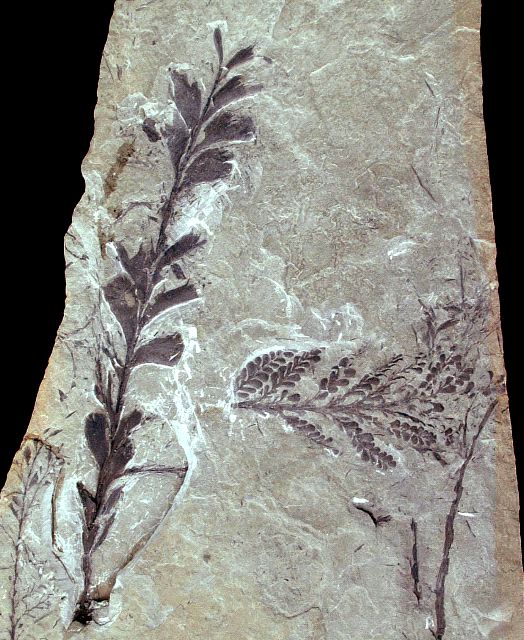The plants of Miguasha
Fossil plant specimens at Miguasha are dominated by at most five species. Other Upper Devonian areas have revealed much more diverse assemblages.
 (96 kb) Compared, for example, with flora from the beginning of the Frasnian Age in the state of New York, the Escuminac Formation at Miguasha lacks typical groups like the aneurophyte progymnosperms, cladoxylopsids, iridopterids and lycophytes.
(96 kb) Compared, for example, with flora from the beginning of the Frasnian Age in the state of New York, the Escuminac Formation at Miguasha lacks typical groups like the aneurophyte progymnosperms, cladoxylopsids, iridopterids and lycophytes.
Even so, fossil spores in the rocks reveal that the Miguasha habitat was not nearly as species-poor as the fossil record might indicate. It seems that the apparent lack of plant diversity is the result of the small size of the fossiliferous outcrop available for sampling, or the effect of selective sorting of species while being transported by a current before fossilization.
Plant fossils of the Escuminac Formation are divided into two assemblages: Protobarinophyton and Archaeopteris. The assemblage in the layer containing Protobarinophyton, a plant that lived on the banks of the ancient estuary, suggests it underwent a short transport distance compared to the assemblage containing Archaeopteris, a tree that preferred to establish itself some distance from the bank where the soil was more stable. Desiccation cracks in sediment layers containing Protobarinophyton are evidence of an environment that was sporadically exposed to air. In contrast, sedimentary structures associated with the best Archaeopteris-bearing layers suggest strong currents.
The case of paleoflora (ancient plants) is an excellent example of how paleontologists must deal with natural “filters” that come between the original ancient environment and the researcher who attempts to interpret it. Miguasha illustrates this point well: only plants that died in the waves of the estuary, or whose remains were washed into it, could eventually become fossilized, and the fossil record thus excludes any species that lived too far from the water’s edge. Even then, the sediments in which the plants fell must have survived as sedimentary rock or their precious information would be lost forever.

 (96 kb) Compared, for example, with flora from the beginning of the Frasnian Age in the state of New York, the Escuminac Formation at Miguasha lacks typical groups like the aneurophyte progymnosperms, cladoxylopsids, iridopterids and lycophytes.
(96 kb) Compared, for example, with flora from the beginning of the Frasnian Age in the state of New York, the Escuminac Formation at Miguasha lacks typical groups like the aneurophyte progymnosperms, cladoxylopsids, iridopterids and lycophytes.Even so, fossil spores in the rocks reveal that the Miguasha habitat was not nearly as species-poor as the fossil record might indicate. It seems that the apparent lack of plant diversity is the result of the small size of the fossiliferous outcrop available for sampling, or the effect of selective sorting of species while being transported by a current before fossilization.
Plant fossils of the Escuminac Formation are divided into two assemblages: Protobarinophyton and Archaeopteris. The assemblage in the layer containing Protobarinophyton, a plant that lived on the banks of the ancient estuary, suggests it underwent a short transport distance compared to the assemblage containing Archaeopteris, a tree that preferred to establish itself some distance from the bank where the soil was more stable. Desiccation cracks in sediment layers containing Protobarinophyton are evidence of an environment that was sporadically exposed to air. In contrast, sedimentary structures associated with the best Archaeopteris-bearing layers suggest strong currents.
The case of paleoflora (ancient plants) is an excellent example of how paleontologists must deal with natural “filters” that come between the original ancient environment and the researcher who attempts to interpret it. Miguasha illustrates this point well: only plants that died in the waves of the estuary, or whose remains were washed into it, could eventually become fossilized, and the fossil record thus excludes any species that lived too far from the water’s edge. Even then, the sediments in which the plants fell must have survived as sedimentary rock or their precious information would be lost forever.
Site map | Feedback | Links | Sources | Credits
The plants of Miguasha
<< The first forests | Protobarinophyton >>

Title: A layer of Archaeopteris fossils
Author: Parc national de Miguasha
Sources: Parc national de Miguasha
Year: 2003
Description:
The fossil plant Archaeopteris is abundant in several layers of the Escuminac Formation. This example contains both species found at Miguasha. The one with the larger leaves is Archaeopteris obtusa and the other A. halliana.


